

Simple Linked Data Publishing For Non Programmers from Kingsley Idehen on 2012-07-25 (public-lod from July 2012) Openlink/virtuoso-opensource. Tim Berners-Lee. Biography A graduate of Oxford University, Tim Berners-Lee invented the World Wide Web, an internet-based hypermedia initiative for global information sharing while at CERN, the European Particle Physics Laboratory, in 1989.

He wrote the first web client and server in 1990. His specifications of URIs, HTTP and HTML were refined as Web technology spread. He is the 3Com Founders Professor of Engineering in the School of Engineering with a joint appointment in the Department of Electrical Engineering and Computer Science at the Laboratory for Computer Science and Artificial Intelligence ( CSAIL) at the Massachusetts Institute of Technology (MIT) where he also heads the Decentralized Information Group (DIG).
He is also a Professor in the Electronics and Computer Science Department at the University of Southampton, UK. Linked Data - Design Issues. Up to Design Issues The Semantic Web isn't just about putting data on the web.
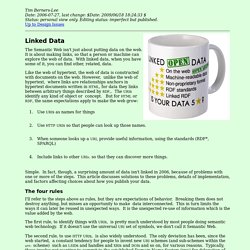
It is about making links, so that a person or machine can explore the web of data. Linked Data - Connect Distributed Data across the Web. Dereferenceable Uniform Resource Identifier. A dereferenceable Uniform Resource Identifier or dereferenceable URI is a resource retrieval mechanism that uses any of the internet protocols (e.g.
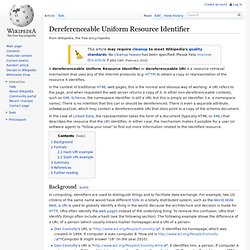
HTTP) to obtain a copy or representation of the resource it identifies. In the context of traditional HTML web pages, this is the normal and obvious way of working: A URI refers to the page, and when requested the web server returns a copy of it. In other non-dereferenceable contexts, such as XML Schema, the namespace identifier is still a URI, but this is simply an identifier (i.e. a namespace name). There is no intention that this can or should be dereferenced. There is even a separate attribute, schemaLocation, which may contain a dereferenceable URI that does point to a copy of the schema document. SPARQLbin.com. Toward a Basic Profile for Linked Data. Update In March 2012, IBM and its partners submitted the Linked Data Basic Profile specification to W3C. Motivation There is interest in using Linked Data technologies for more than one purpose. We have seen interest in it to expose information -- public records, for example -- on the Internet in a machine-readable format.
We have also seen interest in using it for inferring new information from existing information, for example in pharmaceutical applications or IBM Watson™ (see the Resources section for links to more information). The IBM® Rational® team has been using Linked Data as an architectural model and implementation technology for application integration. Rational software is a vendor of software development tools, particularly those that support the general software development process, such as bug tracking, requirements management, and test management tools. Resources Containers Paging Validation Back to top Terminology Link Linked Data Specification Basic Profile Client Server URI: URI: Semantic Web. Semantic. The Semantic Web (Web 3.0) How to publish Linked Data on the Web. This document provides a tutorial on how to publish Linked Data on the Web.
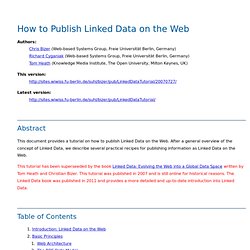
Extensible use of RDF in a Business Context. Kerstin Forsberg, Viktoria Institute and Adera, O Hamngatan 41-43, S-411 10 Gothenburg Sweden, kerstin.forsberg@aderagroup.com Lars Dannstedt, Volvo Information Technology, Web Program Center, S-405 08, Gothenburg Sweden, it1.larsd@memo.volvo.se Abstract The next generation of intranets should facilitate the structuring of information as well as the organising of communication in networking organisations.
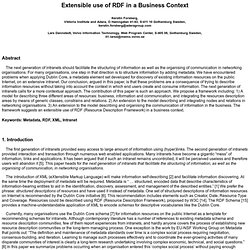
For many organisations, one step in that direction is to structure information by adding metadata. We have encountered problems when applying Dublin Core, a metadata element set developed for discovery of existing information resources on the public Internet, on an extensive intranet. DCMI Home: Dublin Core® Metadata Initiative (DCMI) The Friend of a Friend (FOAF) project. Tools - Semantic Web Standards. Overview This Wiki contains a collection of tool references that can help in developing Semantic Web applications.

These include complete development environments, editors, libraries or modules for various programming languages, specialized browsers, etc. The goal is to list such tools and not Semantic Web applications in general (the interested reader may consider looking at the W3C SW Use Case Collection for those.) The tool content of this wiki is still to be maintained by the community and not by the W3C staff. If you are interested in adding to and/or modifying the relevant pages, please consult the separate Tool Contributors’ page. Search possibilities The current Wiki contains references to 336 tools. Search through categories, i.e., reasoners, programming environments, browsers, etc.
Last modified/added Tool Data in RDF There is also an option to get one RDF/XML graph for all tools. IsaViz Overview. News IsaViz and Java 1.6 (2007-10-21) IsaViz 2.x is not compatible with Java 1.6 or later.
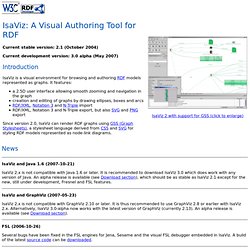
It is recommended to download IsaViz 3.0 which does work with any version of Java. An alpha release is available (see Download section), which should be as stable as IsaViz 2.1 except for the new, still under development, Fresnel and FSL features. IsaViz and GraphViz (2007-05-23) Linked Data - Connect Distributed Data across the Web.